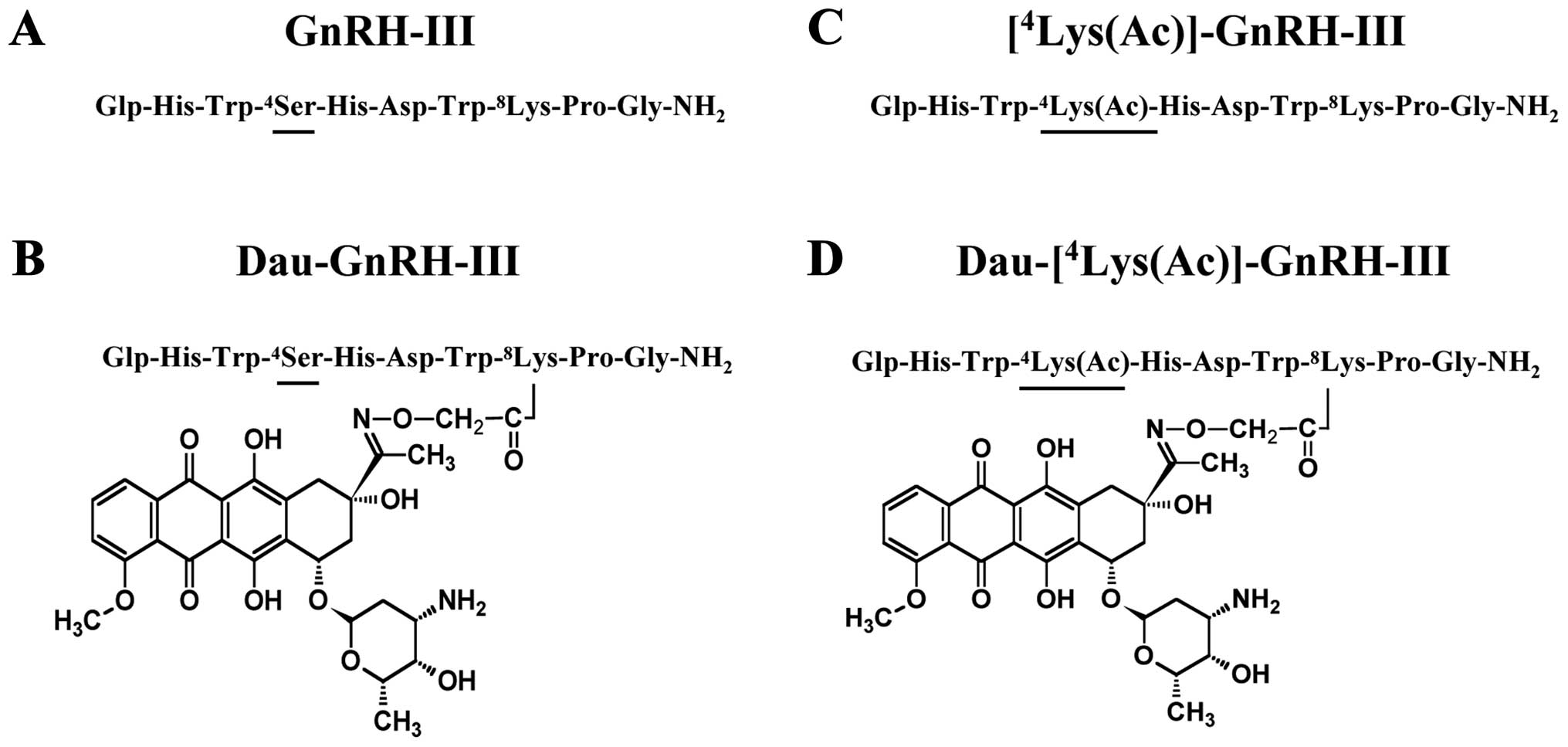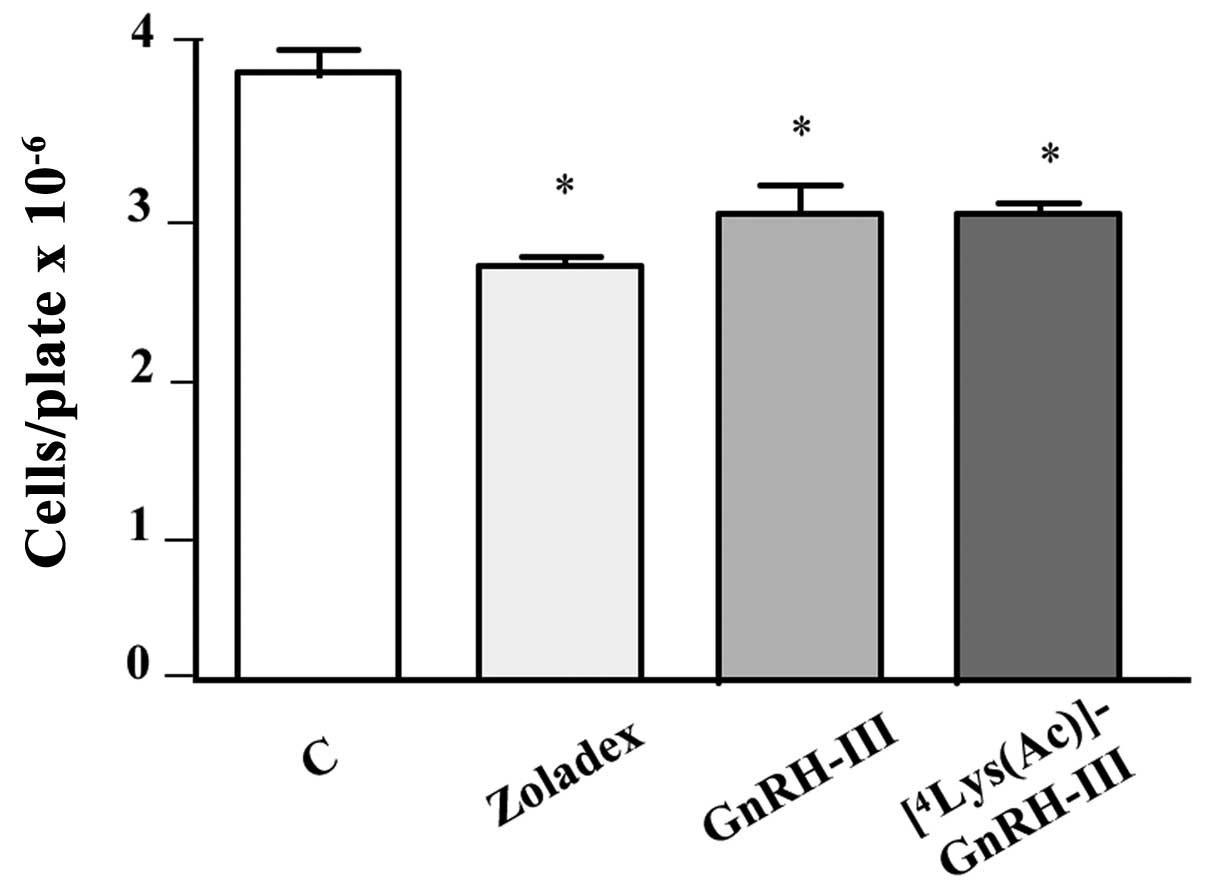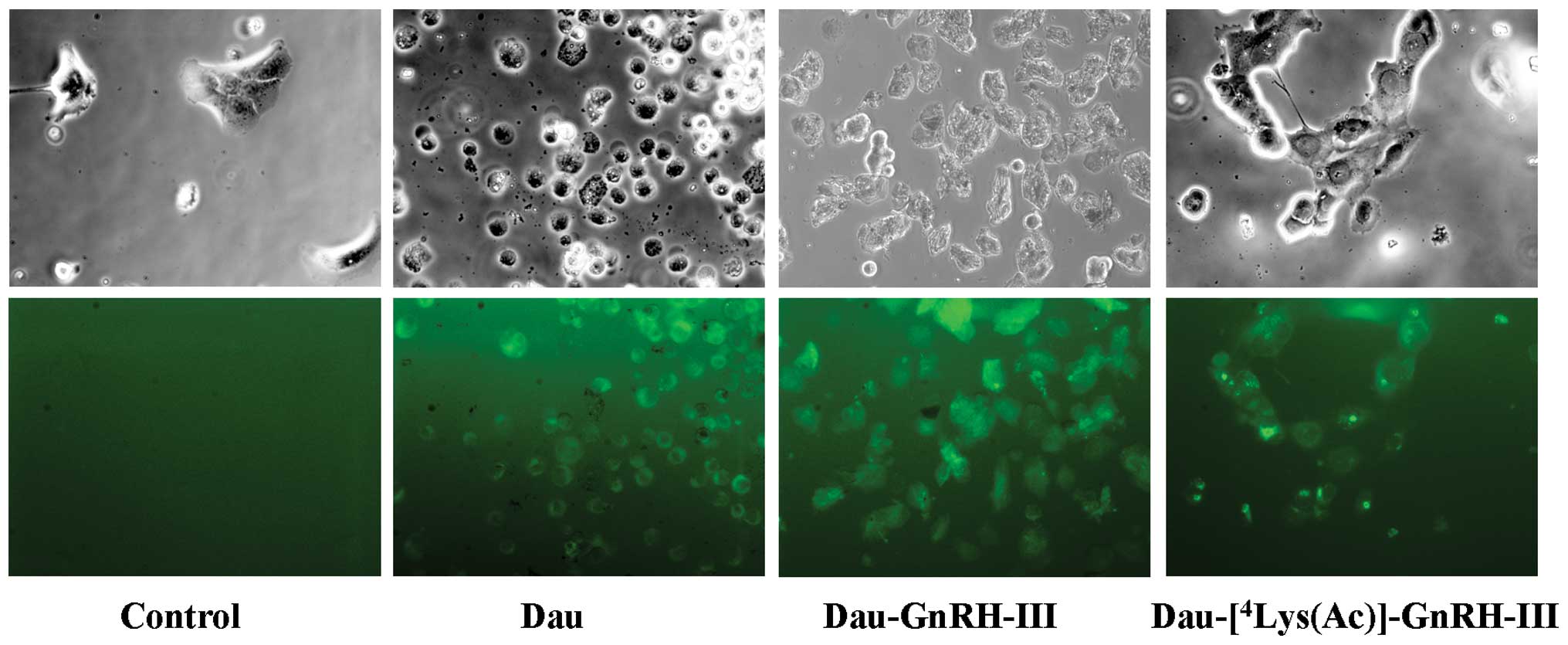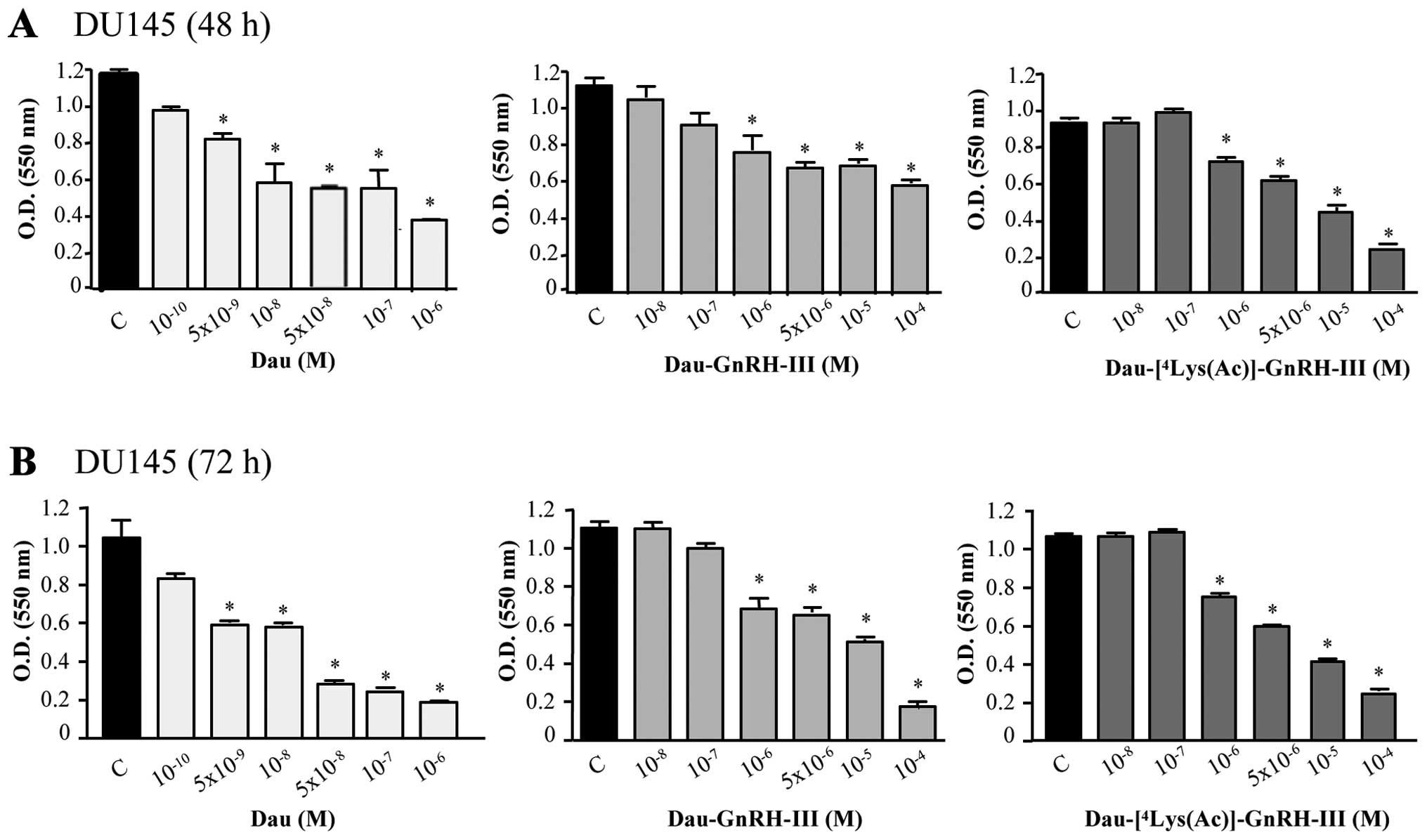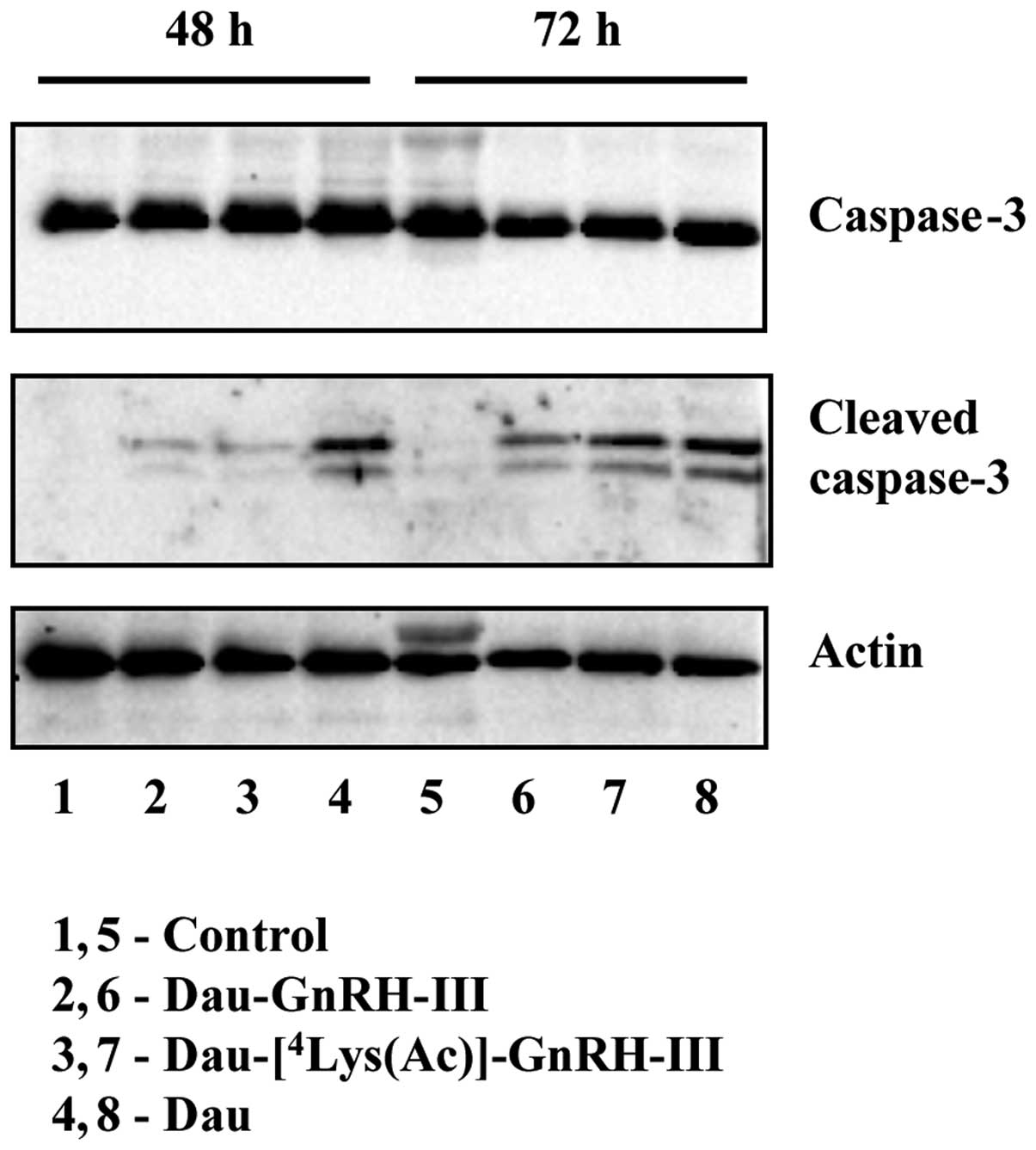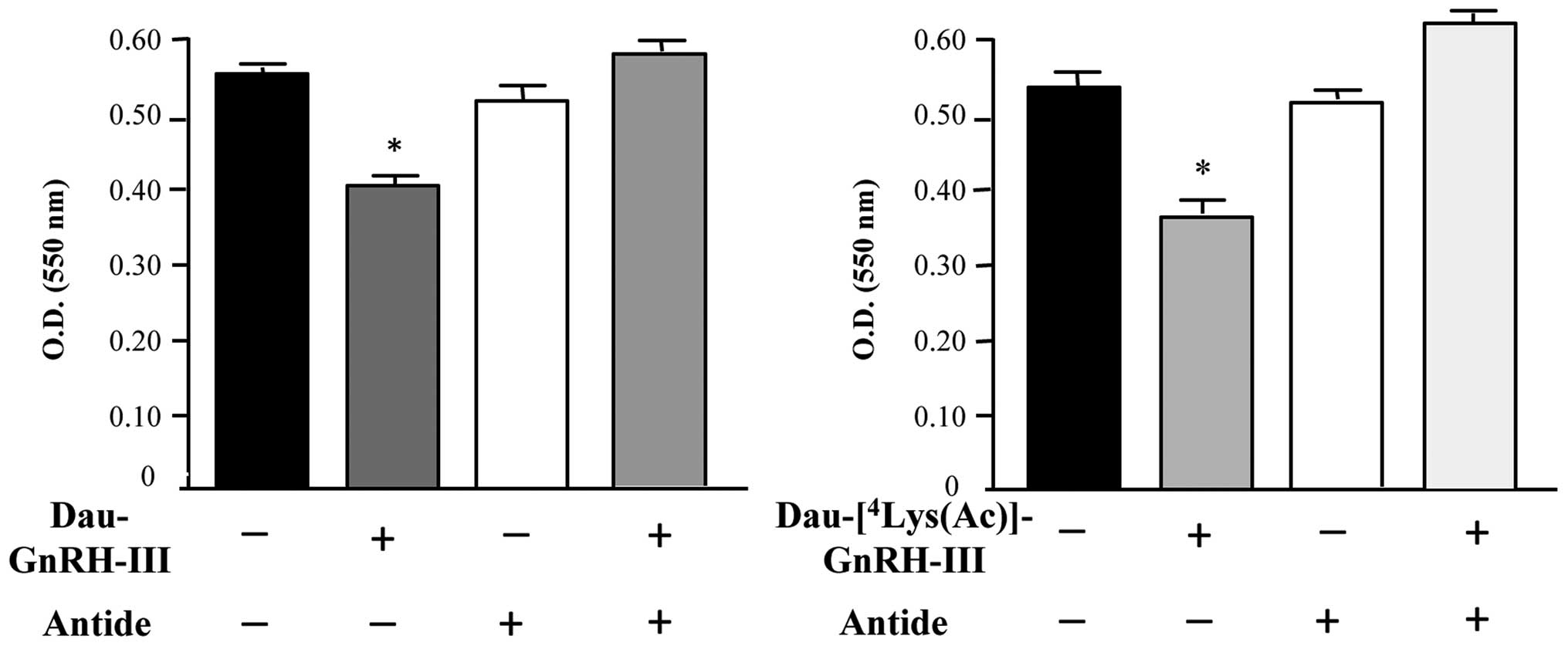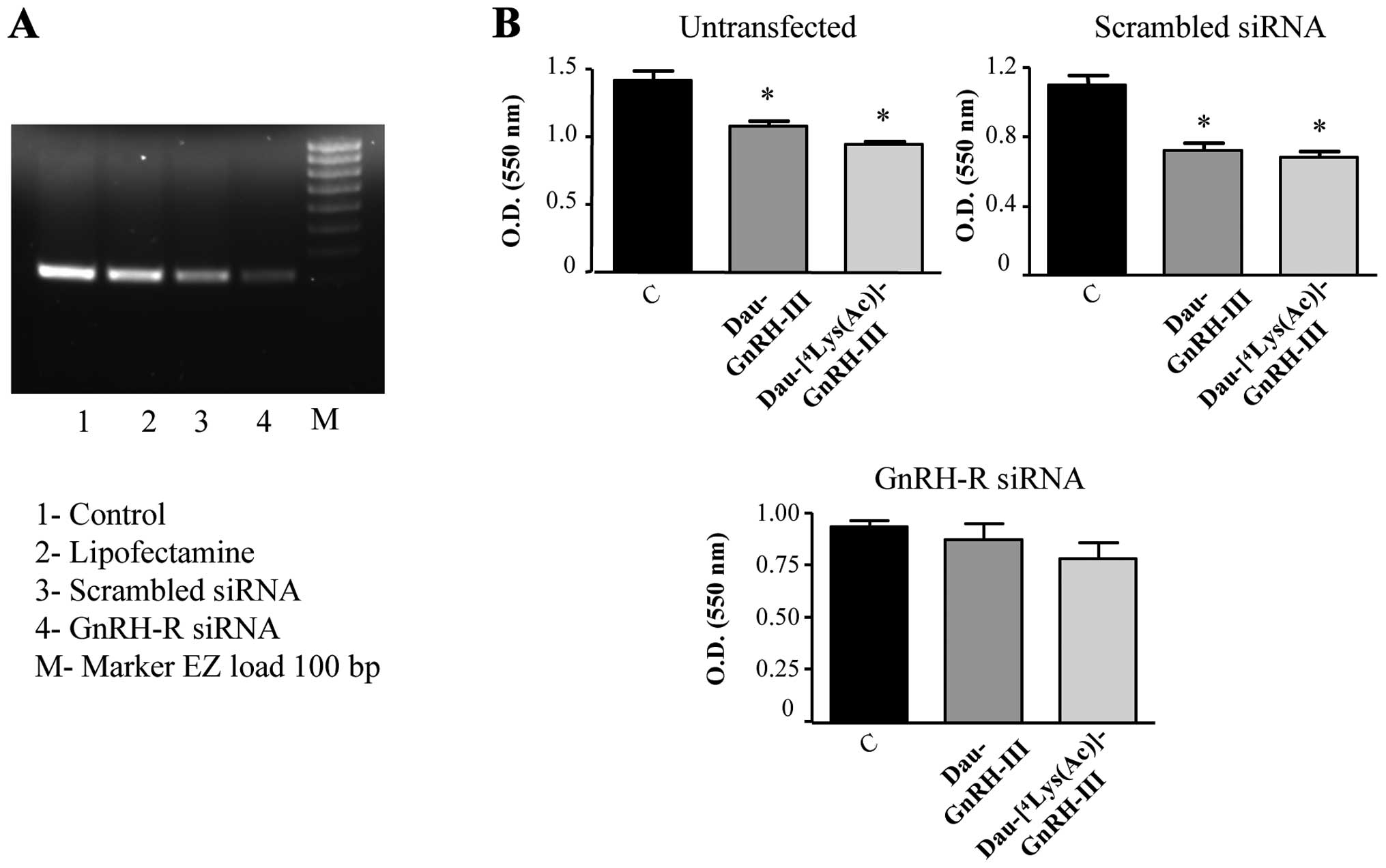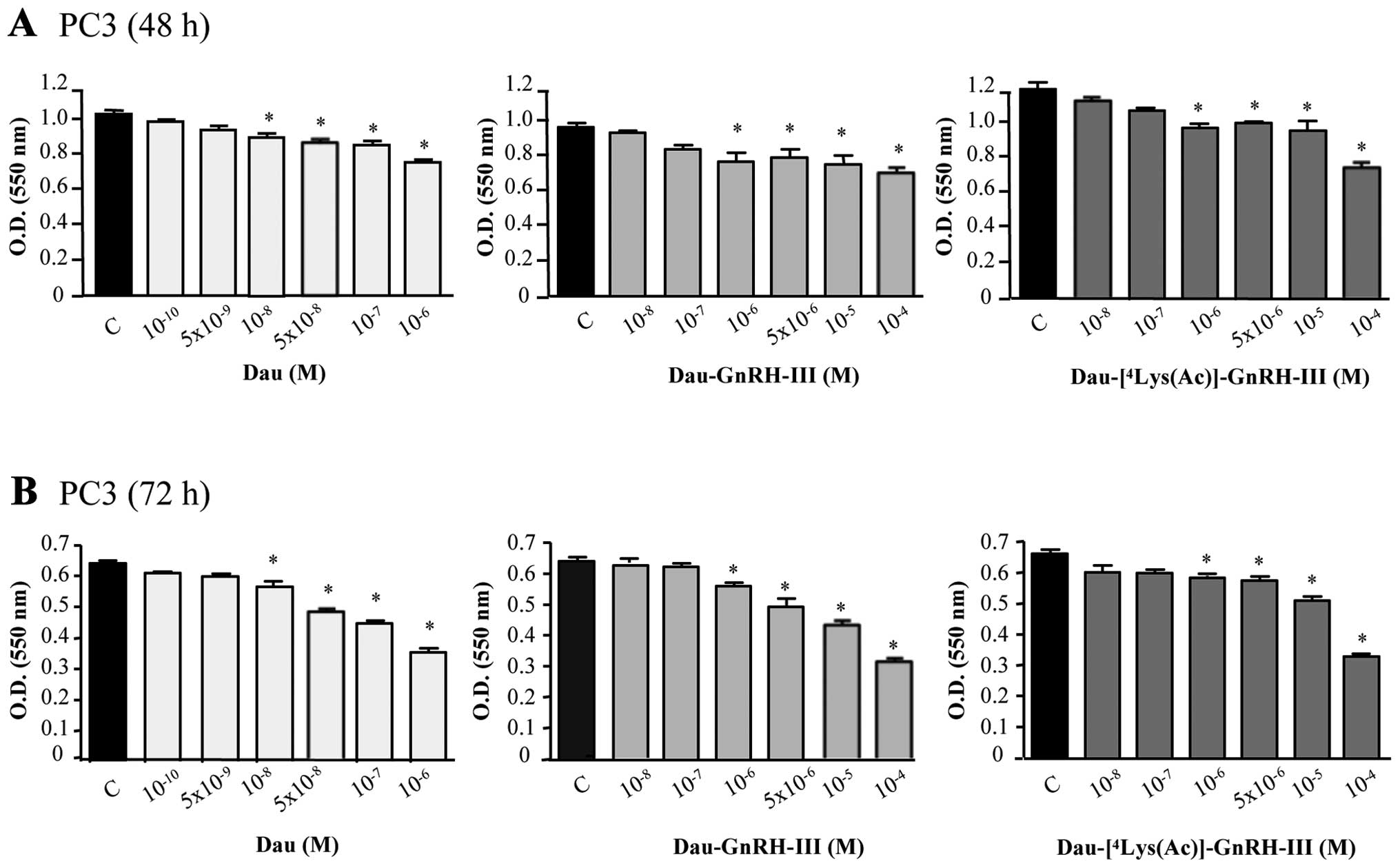|
1
|
Schally AV, Arimura A, Baba Y, Nair RM,
Matsuo H, Redding TW and Debeljuk L: Isolation and properties of
the FSH and LH-releasing hormone. Biochem Biophys Res Commun.
43:393–399. 1971. View Article : Google Scholar : PubMed/NCBI
|
|
2
|
Kakar SS, Malik MT, Winters SJ and
Mazhawidza W: Gonadotropin-releasing hormone receptors: structure,
expression, and signaling transduction. Vitam Horm. 69:151–207.
2004. View Article : Google Scholar : PubMed/NCBI
|
|
3
|
Millar RP: GnRHs and GnRH receptors. Anim
Reprod Sci. 88:5–28. 2005. View Article : Google Scholar
|
|
4
|
Emons G and Schally AV: The use of
luteinizing hormone releasing hormone agonists and antagonists in
gynaecological cancers. Hum Reprod. 9:1364–1379. 1994.PubMed/NCBI
|
|
5
|
Labrie F, Belanger A, Luu-The V, et al:
Gonadotropin-releasing hormone agonists in the treatment of
prostate cancer. Endocr Rev. 26:361–379. 2005. View Article : Google Scholar : PubMed/NCBI
|
|
6
|
Imai A and Tamaya T: GnRH receptor and
apoptotic signaling. Vitam Horm. 59:1–33. 2000. View Article : Google Scholar
|
|
7
|
Grundker C, Gunthert AR, Westphalen S and
Emons G: Biology of the gonadotropin-releasing hormone system in
gynecological cancers. Eur J Endocrinol. 146:1–14. 2002. View Article : Google Scholar : PubMed/NCBI
|
|
8
|
Montagnani Marelli M, Moretti RM,
Januszkiewicz-Caulier J, Motta M and Limonta P:
Gonadotropin-releasing hormone (GnRH) receptors in tumors: a new
rationale for the therapeutical application of GnRH analogs in
cancer patients? Curr Cancer Drug Targets. 6:257–269.
2006.PubMed/NCBI
|
|
9
|
Limonta P, Montagnani Marelli M, Mai S,
Motta M, Martini L and Moretti RM: GnRH receptors in cancer: from
cell biology to novel targeted therapeutic strategies. Endocr Rev.
33:784–811. 2012. View Article : Google Scholar : PubMed/NCBI
|
|
10
|
Limonta P and Manea M:
Gonadotropin-releasing hormone receptors as molecular therapeutic
targets in prostate cancer: Current options and emerging
strategies. Cancer Treat Rev. 39:647–663. 2013. View Article : Google Scholar : PubMed/NCBI
|
|
11
|
Engel J, Emons G, Pinski J and Schally AV:
AEZS-108 : a targeted cytotoxic analog of LHRH for the treatment of
cancers positive for LHRH receptors. Expert Opin Investig Drugs.
21:891–899. 2012. View Article : Google Scholar : PubMed/NCBI
|
|
12
|
Kovacs M, Seprodi J, Koppan M, Horvath JE,
Vincze B, Teplan I and Flerko B: Lamprey gonadotropin
hormone-releasing hormone-III has no selective follicle-stimulating
hormone-releasing effect in rats. J Neuroendocrinol. 14:647–655.
2002. View Article : Google Scholar : PubMed/NCBI
|
|
13
|
Szabo I, Manea M, Orban E, et al:
Development of an oxime bond containing
daunorubicin-gonadotropin-releasing hormone-III conjugate as a
potential anticancer drug. Bioconjug Chem. 20:656–665. 2009.
View Article : Google Scholar : PubMed/NCBI
|
|
14
|
Manea M, Leurs U, Orban E, et al: Enhanced
enzymatic stability and antitumor activity of daunorubicin-GnRH-III
bioconjugates modified in position 4. Bioconjug Chem. 22:1320–1329.
2011. View Article : Google Scholar : PubMed/NCBI
|
|
15
|
Orban E, Mezo G, Schlage P, et al: In
vitro degradation and antitumor activity of oxime bond-linked
daunorubicin-GnRH-III bioconjugates and DNA-binding properties of
daunorubicin-amino acid metabolites. Amino Acids. 41:469–483. 2011.
View Article : Google Scholar : PubMed/NCBI
|
|
16
|
Schlage P, Mezo G, Orban E, Bosze S and
Manea M: Anthracycline-GnRH derivative bioconjugates with different
linkages: synthesis, in vitro drug release and cytostatic effect. J
Control Release. 156:170–178. 2011. View Article : Google Scholar : PubMed/NCBI
|
|
17
|
Siegel R, Ma J, Zou Z and Jemal A: Cancer
statistics, 2014. CA Cancer J Clin. 64:9–29. 2014. View Article : Google Scholar
|
|
18
|
Akaza H: Combined androgen blockade for
prostate cancer: review of efficacy, safety and cost-effectiveness.
Cancer Sci. 102:51–56. 2011. View Article : Google Scholar : PubMed/NCBI
|
|
19
|
Fitzpatrick JM: Management of
castration-resistant prostate cancer: a call to urologists. BJU
Int. 110:772–774. 2012. View Article : Google Scholar : PubMed/NCBI
|
|
20
|
Lee DJ, Cha EK, Dubin JM, et al: Novel
therapeutics for the management of castration-resistant prostate
cancer (CRPC). BJU Int. 109:968–985. 2012. View Article : Google Scholar : PubMed/NCBI
|
|
21
|
Dondi D, Limonta P, Moretti RM, Montagnani
Marelli M, Garattini E and Motta M: Antiproliferative effects of
lutein-izing hormone-releasing hormone (LHRH) agonists on human
androgen-independent prostate cancer cell line DU 145: evidence for
an autocrine-inhibitory LHRH loop. Cancer Res. 54:4091–4095.
1994.
|
|
22
|
Dondi D, Moretti RM, Montagnani Marelli M,
et al: Growth-inhibitory effects of luteinizing hormone-releasing
hormone (LHRH) agonists on xenografts of the DU 145 human
androgen-independent prostate cancer cell line in nude mice. Int J
Cancer. 76:506–511. 1998. View Article : Google Scholar : PubMed/NCBI
|
|
23
|
Limonta P, Moretti RM, Montagnani Marelli
M, Dondi D, Parenti M and Motta M: The luteinizing
hormone-releasing hormone receptor in human prostate cancer cells:
messenger ribonucleic acid expression, molecular size, and signal
transduc-tion pathway. Endocrinology. 140:5250–5256. 1999.
|
|
24
|
Montagnani Marelli M, Moretti RM, Mai S,
Procacci P and Limonta P: Gonadotropin-releasing hormone agonists
reduce the migratory and the invasive behavior of
androgen-independent prostate cancer cells by interfering with the
activity of IGF-I. Int J Oncol. 30:261–271. 2007.PubMed/NCBI
|
|
25
|
Montagnani Marelli M, Moretti RM, Mai S,
Januszkiewicz-Caulier J, Motta M and Limonta P: Type I
gonadotropin-releasing hormone receptor mediates the
antiproliferative effects of GnRH-II on prostate cancer cells. J
Clin Endocrinol Metab. 94:1761–1767. 2009.PubMed/NCBI
|
|
26
|
Gnanapragasam VJ, Darby S, Khan MM, Lock
WG, Robson CN and Leung HY: Evidence that prostate
gonadotropin-releasing hormone receptors mediate an
anti-tumourigenic response to analogue therapy in hormone
refractory prostate cancer. J Pathol. 206:205–213. 2005. View Article : Google Scholar
|
|
27
|
Liu SV, Schally AV, Hawes D, et al:
Expression of receptors for luteinizing hormone-releasing hormone
(LH-RH) in prostate cancers following therapy with LH-RH agonists.
Clin Cancer Res. 16:4675–4680. 2010. View Article : Google Scholar : PubMed/NCBI
|
|
28
|
Palyi I, Vincze B, Lovas S, et al:
Gonadotropin-releasing hormone analogue conjugates with strong
selective antitumor activity. Proc Natl Acad Sci USA. 96:2361–2366.
1999. View Article : Google Scholar : PubMed/NCBI
|
|
29
|
Hong SW, Shin JS, Moon JH, et al:
NVP-BEZ235, a dual PI3K/mTOR inhibitor, induces cell death through
alternate routes in prostate cancer cells depending on the PTEN
genotype. Apoptosis. 19:895–904. 2014. View Article : Google Scholar : PubMed/NCBI
|
|
30
|
Engel JB, Schally AV, Buchholz S, Seitz S,
Emons G and Ortmann O: Targeted chemotherapy of endometrial,
ovarian and breast cancers with cytotoxic analogs of luteinizing
hormone-releasing hormone (LHRH). Arch Gynecol Obstet. 286:437–442.
2012. View Article : Google Scholar : PubMed/NCBI
|
|
31
|
Emons G, Gorchev G, Harter P, et al:
Efficacy and safety of AEZS-108 (LHRH agonist linked to
doxorubicin) in women with advanced or recurrent endometrial cancer
expressing LHRH receptors: a multicenter phase 2 trial (AGO-GYN5).
Int J Gynecol Cancer. 24:260–265. 2014. View Article : Google Scholar : PubMed/NCBI
|
|
32
|
Szepeshazi K, Schally AV, Keller G, et al:
Receptor-targeted therapy of human experimental urinary bladder
cancers with cytotoxic LH-RH analog AN-152 [AEZS-108]. Oncotarget.
3:686–699. 2012.PubMed/NCBI
|
|
33
|
Jaszberenyi M, Schally AV, Block NL, Nadji
M, Vidaurre I, Szalontay L and Rick FG: Inhibition of U-87 MG
glioblastoma by AN-152 (AEZS-108), a targeted cytotoxic analog of
luteinizing hormone-releasing hormone. Oncotarget. 4:422–432.
2013.PubMed/NCBI
|
|
34
|
Szepeshazi K, Schally AV, Block NL, et al:
Powerful inhibition of experimental human pancreatic cancers by
receptor targeted cytotoxic LH-RH analog AEZS-108. Oncotarget.
4:751–760. 2013.PubMed/NCBI
|
|
35
|
Manea M, Tovari J, Tejeda M, Schulcz A,
Kapuvari B, Vincze B and Mezo G: In-vivo antitumour effect of
daunorubicin-GnRH-III derivative conjugates on colon
carcinoma-bearing mice. Anticancer Drugs. 23:90–97. 2012.
View Article : Google Scholar : PubMed/NCBI
|
|
36
|
Letsch M, Schally AV, Szepeshazi K, Halmos
G and Nagy A: Preclinical evaluation of targeted cytotoxic
luteinizing hormone-releasing hormone analogue AN-152 in
androgen-sensitive and insensitive prostate cancers. Clin Cancer
Res. 9:4505–4513. 2003.
|
|
37
|
Karampelas T, Argyros O, Sayyad N, et al:
GnRH-gemcitabine conjugates for the treatment of
androgen-independent prostate cancer: pharmacokinetic enhancements
combined with targeted drug delivery. Bioconjug Chem. 25:813–823.
2014. View Article : Google Scholar
|
|
38
|
Hegedüs R, Manea M, Orbán E, et al:
Enhanced cellular uptake and in vitro antitumor activity of
short-chain fatty acid acylated daunorubicin-GnRH-III
bioconjugates. Eur J Med Chem. 56:155–165. 2012.PubMed/NCBI
|
|
39
|
Cheng CK and Leung PC: Molecular biology
of gonadotropin-releasing hormone (GnRH)-I, GnRH-II, and their
receptors in humans. Endocr Rev. 26:283–306. 2005. View Article : Google Scholar : PubMed/NCBI
|
|
40
|
Leurs U, Lajko E, Mezo G, et al: GnRH-III
based multifunctional drug delivery systems containing daunorubicin
and methotrexate. Eur J Med Chem. 52:173–183. 2012. View Article : Google Scholar : PubMed/NCBI
|



